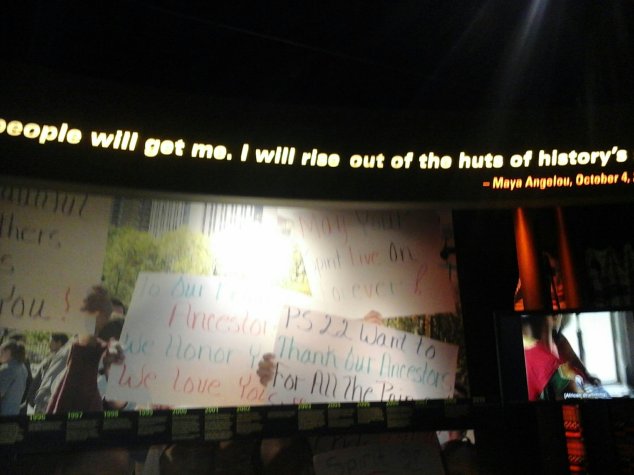

“For All Those Who Were Lost
For All Those Who Were Stolen
For All Those Who Were Left Behind
For All Those Who Were Not Forgotten”
These words are inscribed on a granite wall outside of the African Burial Ground National Monument in New York City .
The wall is hiden by scaffolding now, but the first time that I walked by it , these words spoke to me as they should everyone, not just Americans.
The monument is located right near New York’s City Hall and the oh so many courthouses that may look familiar to you if you watch the t.v. show, Law and Order .
It’s also close by that bridge that seems to dominate the Lower Manhattan skyline, The Brooklyn Bridge .
The monument is part of the United States National Park Service.
It’s open on Tuesdays through Saturdays and the admission is free.
The building is officially located on Elk Street , but right underneath the Elk Street sign is another sign that lets you know that you’re going in the right direction right after you get off the subway at the Chambers Street Station.
The street sign reads “African Burial Ground Way.”
As part of the building is under construction you have to walk around the corner to the entrance.
The monument was officially open in 2006.
As you walk into the building and see all the exhibits, you notice two things.
One that slavery did take place in New York City, and how the city had more slaves than any city in the South including Charleston, South Carolina.
You’ll also see a West African heart shape figure called a Sankofa.
You’ll see it a lot throughout your visit.
The Sankofa asks you to “learn from your past so that one may prosper for your future.”
Each exhibit makes you think.
You learn that not only did Europeans sell slaves, some of their fellow Africans did as well.
You also learn, sadly, that if a slave was ill on the voyage to the New World, they were thrown overboard .
What shocks you more, if the exhibits weren’t shocking enough, is that many African slaves and free Negroes, couldn’t be buried in the city or New Amsterdam , as it was called then.
Remains of 419 men, women, and even children, were discovered in the late 1990’s, and finally given the prosper burial they deserved.
The seven mounds that you see that are now covered by scaffolding are the remains of the 419.
One might say that this monument is sobering.
Some people might say that, but it opens your eyes to a part of American History that many Americans don’t know or seem to care about.
African Burial Ground National Monument
290 Broadway , First Floor
New York City , New York 10007
212-637-2019

























Really cool. I had no idea it existed. I have got to get back to NY someday! Thanks and Cheers!!! 🙂
LikeLiked by 1 person
You should. So many new museums and things are opening up here.
LikeLiked by 1 person
I grew up in NY and worked blocks away from this site for 10 years and never knew it existed until recently. I have a post planned for this that should drop later in the year.
LikeLiked by 2 people
That sounds good. Thanks for following my blog!
LikeLiked by 1 person
Thanks again for liking my newest post. So hate this weather that I’m also watching travel videos!
LikeLiked by 1 person